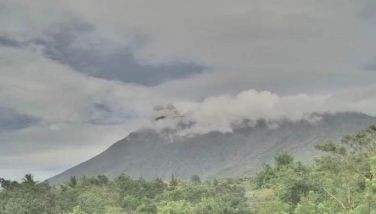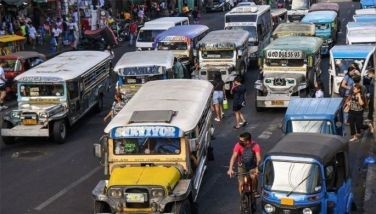Many RP rivers, mountains still healthy
March 24, 2006 | 12:00am
Many of the country’s mountains and rivers are still lush and clean.
The good state of health of several mountains, rivers, and mangroves was found in studies done by members of the country’s research and development (R&D) sector.
Take Mt. Malindang in the Northern Mindanao province of Misamis Occidental.
In 2000, it was chosen as the site of the biodiversity research program (BRP) funded by the Netherlands Ministry of Development Cooperation (DGIS).
The implementation of the "Philippine-Netherlands Biodiversity Research Program for Development in Mindanao: Focus on Mt. Malindang and Environs" was overseen by the Los Baños-based, Philippine government-hosted Southeast Asian Regional Center for Graduate Study and Research in Agriculture (SEARCA).
The 12 research projects completed to date looked into the terrestrial and aquatic ecosystems and socioeconomic-cultural aspects within the research area straddling eight towns and one city in Misamis Occidental.
Involved in the activities were Dutch researchers and their Filipino counterparts from 12 universities and colleges in Mindanao, as well as farmers, fisherfolk, local government units, and non-government agencies.
That Mt. Malindang is still lush can be attested by its rich flora and fauna: 494 species of plants, 99 species of birds, and 17 species of mammals (three of which are endemic).
A natural park and a priority protected area, the 53,262-hectare Mt. Malindang has unique volcanic landscape and biodiversity that exemplify the nature and elements of threats to biodiversity management and consideration in the Philippines.
Another study done by researchers of the Central Mindanao University (CMU) based in Musuan, Bukidnon, noted that Mt. Malindang also nurtures 741 species of arthropods (invertebrate animals that include spiders, insects, crustaceans, and their relatives).
Also in Misamis Occidental, the Langaran and Lawayan Rivers were classified as Recreational Water 1, which means it is suitable for bathing and swimming.
The Lawayan River has been named the cleanest and greenest river in Northern Mindanao, suggesting that its quality surpasses that of any river, based on some standards.
The Langaran River also has good water quality according to a study done by Rommel Seronay of the Northern Mindanao State Institute of Science and Technology (MORMISIST) in Butuan City.
The assessment results were compared with the water quality criteria or water usage and classification of fresh water system of the Department of Environment and Natural Resources (DENR).
Results of the NORMISIST study were among those presented recently at the CARAGA Consortium for Agriculture and Resources Research and Development (C-CARRDEC) Regional Symposium on R&D held at NORMISIST.
In Davao Oriental, Mt. Hamiguitan, popularly known as the home of the Philippine Eagle and the Mandaya tribe, still nurtures prized ornamentals and other important plants.
A survey conducted by Dr. Victory Amoroso and Reyno Aspiras of CMU and Oda Beltran of the Bukidnon Resources Management Foundation Inc. (BRMFI) showed that Mt. Hamiguitan is home to 59 economically important plants (ornamentals, lumber/wood species, medicinal, edible, raw materials for handicraft), 44 endemic, 27 rare, and five endangered species.
Mt. Hamiguitan has four vegetation types — dipterocarp forest, montane forest (mosses, lichens, epiphytes), bonsai "pymy" forest, and agroecosystem.
There is also a "patch of green" in the otherwise "brown province" that is Cebu.
A study done by researchers of the Cebu State College of Science and Technology (CSCST) determined Argao’s watershed species and vegetation types, described its biophysical components, and formulated recommendations to improve its resource management.
Of the four vegetation types (grassland, plantation, second growth forest, and natural forest) taken as samples, the presence of 352 species belonging to 87 families and 159 general of plants were detected in the study area.
The species included large, medium, and small trees, shrubs, palms, herbs, lianas, vines, ferns, grass, mosses, orchids, and other unidentified species.
With these findings, the CSCST researchers recommended further documentation of floral resources in the watershed, protection of its remaining resources, strict implementation of its management and rehabilitation of its degraded sites through planting of native species.
The mangrove ecosystems in Masinloc, Zambales were also found to be still in healthy states, according to researchers Rowena Sazon of the Ramon Magsaysay Technological University (RMTU) in Iba town, and Antonio Gascon of the UP Los Baños-Institute of Renewable Natural Resources.
Among the factors that contributed to the healthy state of the Mindanao mangroves were the communities’ awareness of their importance and particular attention given to livelihood activities and rehabilitation practices.
Threats to the conservation of the mangroves include the use of sayudsod in catching shrimps, crab harvesting by soil digging, water pollution, coastal development, squatting, continued fishpond development, and lack of formal regulations.
The studies showed that one big factor in the rehabilitation of deforested mountain areas in the country is the people’s increasing awareness of their role as protectors and guardians of natural resources.
This is exemplified in the case of Mt. Isarog, the highest mountain peak in the Bicol Region.
There was a time when the storied Mt. Isarog Natural Park was in bad shape. Then the Metro Naga Water District and concerned people in the area took upon themselves the task of rehabilitating the denuded watershed.
Today, Dr. Celerino Llesol and Prof. Arthur Estrella of the Camarines Sur State Agricultural College (CSSAC) and Raul Bradecina of the Partido State University (PSU) in Sagñay, Camarines Sur, said that Mt. Isarog’s vegetation cover ranges from 80 to 100 percent, particularly in areas without illegal settlers.
The good state of health of several mountains, rivers, and mangroves was found in studies done by members of the country’s research and development (R&D) sector.
Take Mt. Malindang in the Northern Mindanao province of Misamis Occidental.
In 2000, it was chosen as the site of the biodiversity research program (BRP) funded by the Netherlands Ministry of Development Cooperation (DGIS).
The implementation of the "Philippine-Netherlands Biodiversity Research Program for Development in Mindanao: Focus on Mt. Malindang and Environs" was overseen by the Los Baños-based, Philippine government-hosted Southeast Asian Regional Center for Graduate Study and Research in Agriculture (SEARCA).
The 12 research projects completed to date looked into the terrestrial and aquatic ecosystems and socioeconomic-cultural aspects within the research area straddling eight towns and one city in Misamis Occidental.
Involved in the activities were Dutch researchers and their Filipino counterparts from 12 universities and colleges in Mindanao, as well as farmers, fisherfolk, local government units, and non-government agencies.
That Mt. Malindang is still lush can be attested by its rich flora and fauna: 494 species of plants, 99 species of birds, and 17 species of mammals (three of which are endemic).
A natural park and a priority protected area, the 53,262-hectare Mt. Malindang has unique volcanic landscape and biodiversity that exemplify the nature and elements of threats to biodiversity management and consideration in the Philippines.
Another study done by researchers of the Central Mindanao University (CMU) based in Musuan, Bukidnon, noted that Mt. Malindang also nurtures 741 species of arthropods (invertebrate animals that include spiders, insects, crustaceans, and their relatives).
Also in Misamis Occidental, the Langaran and Lawayan Rivers were classified as Recreational Water 1, which means it is suitable for bathing and swimming.
The Lawayan River has been named the cleanest and greenest river in Northern Mindanao, suggesting that its quality surpasses that of any river, based on some standards.
The Langaran River also has good water quality according to a study done by Rommel Seronay of the Northern Mindanao State Institute of Science and Technology (MORMISIST) in Butuan City.
The assessment results were compared with the water quality criteria or water usage and classification of fresh water system of the Department of Environment and Natural Resources (DENR).
Results of the NORMISIST study were among those presented recently at the CARAGA Consortium for Agriculture and Resources Research and Development (C-CARRDEC) Regional Symposium on R&D held at NORMISIST.
In Davao Oriental, Mt. Hamiguitan, popularly known as the home of the Philippine Eagle and the Mandaya tribe, still nurtures prized ornamentals and other important plants.
A survey conducted by Dr. Victory Amoroso and Reyno Aspiras of CMU and Oda Beltran of the Bukidnon Resources Management Foundation Inc. (BRMFI) showed that Mt. Hamiguitan is home to 59 economically important plants (ornamentals, lumber/wood species, medicinal, edible, raw materials for handicraft), 44 endemic, 27 rare, and five endangered species.
Mt. Hamiguitan has four vegetation types — dipterocarp forest, montane forest (mosses, lichens, epiphytes), bonsai "pymy" forest, and agroecosystem.
There is also a "patch of green" in the otherwise "brown province" that is Cebu.
A study done by researchers of the Cebu State College of Science and Technology (CSCST) determined Argao’s watershed species and vegetation types, described its biophysical components, and formulated recommendations to improve its resource management.
Of the four vegetation types (grassland, plantation, second growth forest, and natural forest) taken as samples, the presence of 352 species belonging to 87 families and 159 general of plants were detected in the study area.
The species included large, medium, and small trees, shrubs, palms, herbs, lianas, vines, ferns, grass, mosses, orchids, and other unidentified species.
With these findings, the CSCST researchers recommended further documentation of floral resources in the watershed, protection of its remaining resources, strict implementation of its management and rehabilitation of its degraded sites through planting of native species.
The mangrove ecosystems in Masinloc, Zambales were also found to be still in healthy states, according to researchers Rowena Sazon of the Ramon Magsaysay Technological University (RMTU) in Iba town, and Antonio Gascon of the UP Los Baños-Institute of Renewable Natural Resources.
Among the factors that contributed to the healthy state of the Mindanao mangroves were the communities’ awareness of their importance and particular attention given to livelihood activities and rehabilitation practices.
Threats to the conservation of the mangroves include the use of sayudsod in catching shrimps, crab harvesting by soil digging, water pollution, coastal development, squatting, continued fishpond development, and lack of formal regulations.
The studies showed that one big factor in the rehabilitation of deforested mountain areas in the country is the people’s increasing awareness of their role as protectors and guardians of natural resources.
This is exemplified in the case of Mt. Isarog, the highest mountain peak in the Bicol Region.
There was a time when the storied Mt. Isarog Natural Park was in bad shape. Then the Metro Naga Water District and concerned people in the area took upon themselves the task of rehabilitating the denuded watershed.
Today, Dr. Celerino Llesol and Prof. Arthur Estrella of the Camarines Sur State Agricultural College (CSSAC) and Raul Bradecina of the Partido State University (PSU) in Sagñay, Camarines Sur, said that Mt. Isarog’s vegetation cover ranges from 80 to 100 percent, particularly in areas without illegal settlers.
BrandSpace Articles
<
>
- Latest
- Trending
Trending
Latest
Trending
Latest
Recommended






























